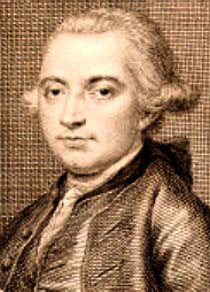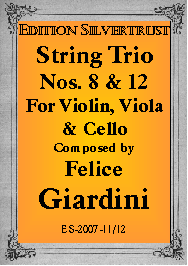Presents
Felice Giardini
|
String Trio No.8 |
 |
String Trio No.12 |
| Soundbite 1st Movt Soundbite 3rd Movt | Soundbite 1st Movt Soundbite 3rd Movt |
String Trios for Violin, Viola & Cello
No.8 in F Major & No.12 in G Major
 Felice
Giardini (1716-1796) was born in Turin. When it became clear that he was a child
prodigy, his father sent him to Milan. There he studied singing, harpsichord and
violin but it was on the latter that he became a famous virtuoso. By the age of
12, he was already playing in theater orchestras. In a famous incident about
this time, Giardini, who was serving as assistant concertmaster during an opera,
played a solo passage for violin, the composer Jomelli had written. He decided
to show off his skills and improvised several bravura variations which Jomelli
had not written. Although the audience applauded loudly, Jomelli, who happened
to be there, was not pleased and suddenly stood up and slapped the young man in
the face. Giardini, years later, remarked, “it was the most instructive
lesson I ever received from a great artist." During the 1750s, Giardini toured
Europe as a violinist, scoring successes in Paris, Berlin, and especially in
England where he eventually settled. For many years, he served as the concertmaster and
director of the Italian Opera in London and gave solo concerts under the
auspices of J.C. Bach with whom he was a close friend. He was widely regarded as
the greatest musical performing artist before the public. (1755-1770). In 1784,
he returned to Naples to run a theater, however, there he encountered financial
setbacks. In 1793, he returned to England to try his luck. But times had
changed and he was no longer remembered. He then went to Russia, but again had
little luck, dying in Moscow in 1796.
Felice
Giardini (1716-1796) was born in Turin. When it became clear that he was a child
prodigy, his father sent him to Milan. There he studied singing, harpsichord and
violin but it was on the latter that he became a famous virtuoso. By the age of
12, he was already playing in theater orchestras. In a famous incident about
this time, Giardini, who was serving as assistant concertmaster during an opera,
played a solo passage for violin, the composer Jomelli had written. He decided
to show off his skills and improvised several bravura variations which Jomelli
had not written. Although the audience applauded loudly, Jomelli, who happened
to be there, was not pleased and suddenly stood up and slapped the young man in
the face. Giardini, years later, remarked, “it was the most instructive
lesson I ever received from a great artist." During the 1750s, Giardini toured
Europe as a violinist, scoring successes in Paris, Berlin, and especially in
England where he eventually settled. For many years, he served as the concertmaster and
director of the Italian Opera in London and gave solo concerts under the
auspices of J.C. Bach with whom he was a close friend. He was widely regarded as
the greatest musical performing artist before the public. (1755-1770). In 1784,
he returned to Naples to run a theater, however, there he encountered financial
setbacks. In 1793, he returned to England to try his luck. But times had
changed and he was no longer remembered. He then went to Russia, but again had
little luck, dying in Moscow in 1796.
Giardini was a prolific composer writing for virtually every genre which then existed. As a string player, he knew how to make string instruments sound their best. His chamber music combines the so-called “Style Gallant” with the mid 18th classicism of J.C. Bach, the Stamitzes and the Mannheim school. In the “Style Gallant”, the writing emphasizes the soloistic qualities of the instruments, rather than the integrated writing of all three parts to create a whole, which J.C. Bach and the Mannheim composers pioneered. While today, the string quartet is the “King” of chamber music ensembles, during the third quarter of the 18th century, the string trio was the most popular chamber ensemble and virtually all of the active composers lavished their talents on them. Boccherini, Haydn, Pleyel and Mozart, to name but a few, all spent time and effort writing trios.
Giardini wrote 18 trios for violin, viola and cello. Nos. 8 and 12 are part of a set of six which were published together as his Op.20 in 1778. He was then at the height of his powers. In these trios, the roles and importance of each instrument is constantly varied. While the viola is often the glue between the violin and the cello, at times, it becomes the the soloist. The cello covers the entire range of its registers, hopping from deep in its bass to high in its tenor. Each of the trios is in three movements.
|
Notes to String Trio No.8 |
Notes to String Trio No.12 |
|
The pleasant, gentle, first movement of No.8 is marked Andante, but this is somewhat deceiving as the music is faster. Here the writing is in concertante style. The second movement, Poco adagio, is the quintessential early classical slow movement. In the vigorous finale, Allegro assai, Giardini begins in the Mannheim style but then switches back and forth between solos and team work.
|
No.12 has an early Mozartian, rousing Andante mosso, for its opening movement. The lovely second movement, Adagio, is a perfect fusion of the Italian vocal style with the Style Gallant. The finale a buoyant Rondo allegro, gives each instrumentalist fine solo passages. |
Out of print for nearly half a century, these are little gems from an elegant and gracious period which we believe amateur trio groups will greatly enjoy.
Trio No.8 Parts: $19.95 / Trio No.12-Parts: $19.95
Special Offer: Both Trios: $27.95